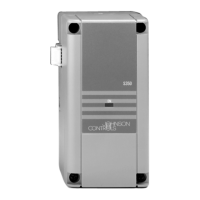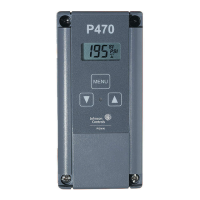System 450™ Series Control Module with Ethernet Communications Installation Instructions
42
4 SENS (Reference
Sensor)
Click the drop-down menu to select the sensor that this output references. The reference
sensor selected for this output is displayed in this field.
Note: If Sn-1 and Sn-2 have the same sensor type, the Sn-d and HI-2 sensors are
available for selection. If Sn-1, Sn-2, and Sn-3 have the same sensor type, the
Sn-d, HI-2 and HI-3 sensors are available for selection.
After a sensor is selected for the output, the sensor number is displayed in the field, along
with the sensor’s sensor type and the usable range of values.
In this example, Sn-1 is the selected reference sensor and Sn-1 is configured as a P 500
sensor type, which provides a 90 to 500 psi range.
5 Sensor Name Displays the assigned sensor name.
Note: You can assign a 16-character (maximum) name for each sensor that you set up on
the Sensor Configuration page.
See Sensor Configuration Page
on page 37 for more information on assigning sensor
names.
6 SP (Setpoint) Enter the desired SP (Setpoint) value for the analog output.
The range of usable values and the Setpoint units of measurement are displayed in the
gray box to the right of the Setpoint field.
Note: The sensor type of the selected reference sensor determines the units of
measurement, the range of usable values, and the minimum differential between the
Setpoint and End Point values.
In this example, the SP value is 225 (psi) and the usable range is 90 to 500 psi.
7 EP (End Point) Enter the EP (End Point) value for the analog output.
The range of usable values and the end point units of measurement are displayed in the
gray box to the right of the End Point field.
Note: The sensor type of the selected reference sensor determines the units of
measurement, the range of usable values, and the minimum differential between the End
Point and Setpoint values.
In this example, the EP value is 250 (psi) and the usable range is 90 to 500 psi.
8 OSP (Output at
Setpoint)
Enter the OSP (Output at Setpoint) value that you want the analog output signal strength to
be when the sensed condition is at SP (Setpoint).
The Output at Setpoint value is a percentage of the total output signal strength range. The
default OSP value is 0 and the range of usable values is 0 to 100.
In this example, the OSP value is 10 (10%).
9 OEP (Output at
End Point)
Enter the OEP (Output at End Point) value that you want the analog output signal strength
to be when the sensed condition is at EP (End Point).
The Output at End Point value is a percentage of the total output signal strength range. The
default OEP value is 100 and the range of usable values is 0 to 100.
In this example, the OEP value is 90 (90%).
10 I-C (Integration
Constant)
Enter the I-C (Integration Constant) value for the output. There are six integration constant
values (1 to 6). The default value (0) indicates that no integration constant is applied to the
analog output.
Note: Johnson Controls recommends using the default value (0) when setting up your
application for the first time. Refer to the System 450™ Series Modular Control Systems
with Communications Control Modules Technical Bulletin (LIT-12011826) for information on
setting up and testing an integration constant for your application.
In this example, the I-C value is the default value 0 and the integration feature is Off.
11 UP-R (Update
Rate)
Enter the UP-R (Update Rate) value at which the analog output signal strength is updated.
You can select an Update Rate value (time-interval in seconds) between 1 and 300.
In this example, the Update Rate value is the default value 1 (second).
Table 17: System 450 Web UI Analog Output Configuration Page, User Actions, Descriptions, and
References (Part 2 of 3)
Callout
Number
Identifier / Item
Name
User Actions, Descriptions, References

